Literacy Instruction Report: Strategies for Learning in PDHPE
VerifiedAdded on 2023/01/18
|10
|2740
|25
Report
AI Summary
This report focuses on literacy instruction within the context of Personal Development, Health, and Physical Education (PDHPE). It begins by selecting PDHPE as the teaching unit for children and then identifies strategies using the multi-literacy framework, which includes situated use, overt instruction, critical framing, and transformed practice. The report then explores opportunities for students based on the four resource model, encompassing code-breaking, text participation, text user, and text analysis. The teaching unit's effectiveness is evaluated, and suggestions for modifications are provided, such as incorporating play-based learning and digital platforms. The report emphasizes the importance of practical learning, student engagement, and adapting teaching methods to enhance the overall learning experience and promote health and physical development.

Running head: Literacy instruction
Literacy instruction
Name of the Student:
Name of the University:
Author Note:
Literacy instruction
Name of the Student:
Name of the University:
Author Note:
Paraphrase This Document
Need a fresh take? Get an instant paraphrase of this document with our AI Paraphraser
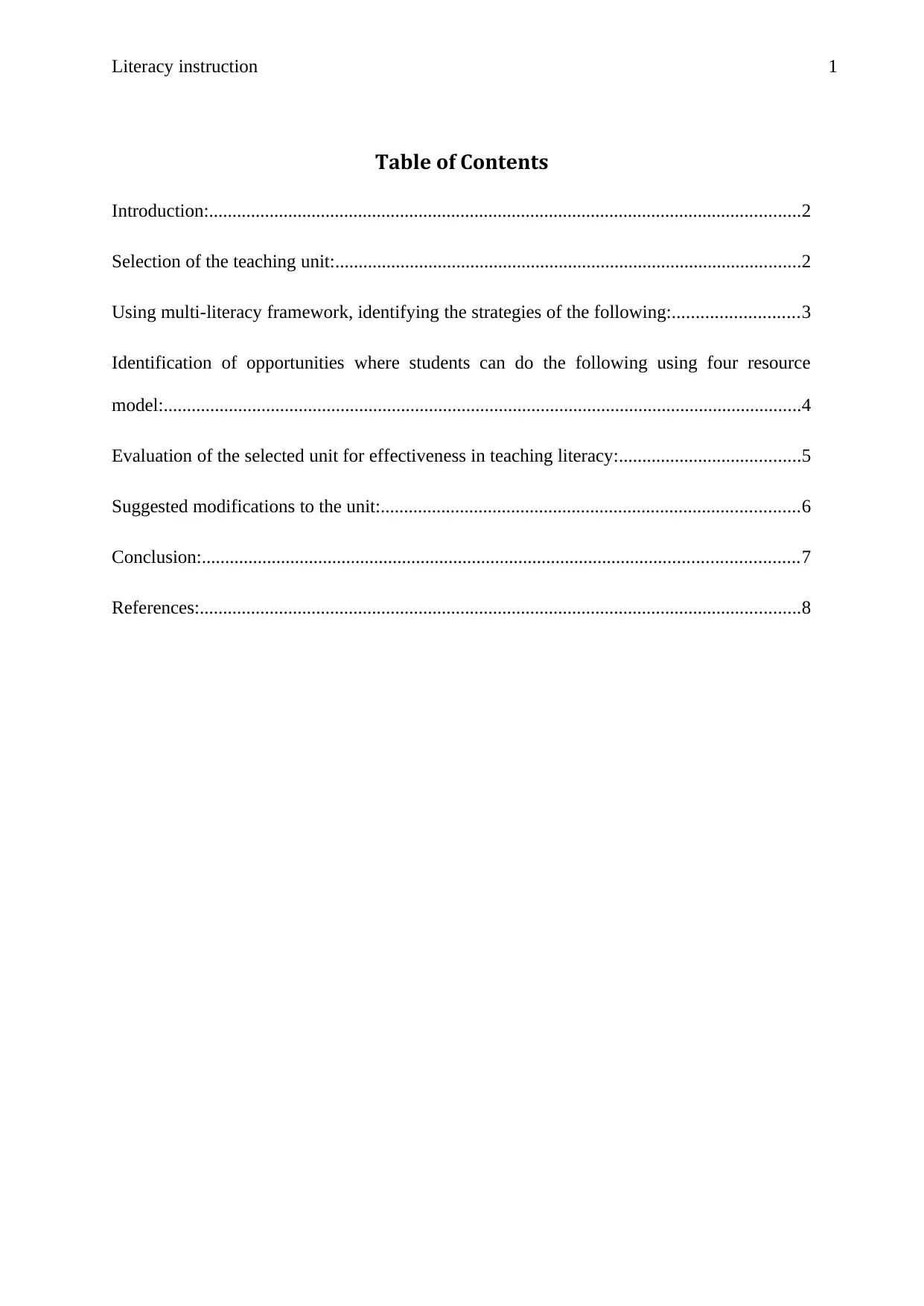
Literacy instruction 1
Table of Contents
Introduction:...............................................................................................................................2
Selection of the teaching unit:....................................................................................................2
Using multi-literacy framework, identifying the strategies of the following:...........................3
Identification of opportunities where students can do the following using four resource
model:.........................................................................................................................................4
Evaluation of the selected unit for effectiveness in teaching literacy:.......................................5
Suggested modifications to the unit:..........................................................................................6
Conclusion:................................................................................................................................7
References:.................................................................................................................................8
Table of Contents
Introduction:...............................................................................................................................2
Selection of the teaching unit:....................................................................................................2
Using multi-literacy framework, identifying the strategies of the following:...........................3
Identification of opportunities where students can do the following using four resource
model:.........................................................................................................................................4
Evaluation of the selected unit for effectiveness in teaching literacy:.......................................5
Suggested modifications to the unit:..........................................................................................6
Conclusion:................................................................................................................................7
References:.................................................................................................................................8

Literacy instruction 2
Introduction:
The aim of this report is to identify and develop a set of literacy instruction for the
children. The way of teaching and learning has always been an area of debate among the
literary experts. Several theories and models have been designed to come up with better plans
to elucidate the process of teaching and make it more comprehensible for the children to
understand and learn (Lundvall, 2015). This report would focus on the area of Personal
Development, Health and Physical Education (PDHPE) among the children. The multi-
literacy framework will be used to identify the strategies involved in teaching the children.
The report will also highlight the opportunities among the students using the four resource
model. The teaching technique will be evaluated and the expected outcome of the teaching
will be discussed in the report with suggested recommendations for changes wherever
required.
Selection of the teaching unit:
Personal Development, Health and Physical Education (PDHPE) are one of the
important school curriculums and it is compulsory in the K-10 stage. The subject involves a
range of activities starting from physical education, mental health education, sports science,
nutrition along with the relationship of children with adults like their family members or
teachers at school (Metzler, 2017). In fact, the wide understanding of other important
concepts like drug abuse, discrimination or harassment is also taught in the lessons of
PDHPE.
The PDHPE will be timetabled for 1.5-2.5 hours a week that meets the governmental
standards. The session would comprise of the activities that would be both engage the
students in some physical activities and at the same time would help them to learn and
achieve the health benefits as well. Thus, this program would help in improving the bodily
Introduction:
The aim of this report is to identify and develop a set of literacy instruction for the
children. The way of teaching and learning has always been an area of debate among the
literary experts. Several theories and models have been designed to come up with better plans
to elucidate the process of teaching and make it more comprehensible for the children to
understand and learn (Lundvall, 2015). This report would focus on the area of Personal
Development, Health and Physical Education (PDHPE) among the children. The multi-
literacy framework will be used to identify the strategies involved in teaching the children.
The report will also highlight the opportunities among the students using the four resource
model. The teaching technique will be evaluated and the expected outcome of the teaching
will be discussed in the report with suggested recommendations for changes wherever
required.
Selection of the teaching unit:
Personal Development, Health and Physical Education (PDHPE) are one of the
important school curriculums and it is compulsory in the K-10 stage. The subject involves a
range of activities starting from physical education, mental health education, sports science,
nutrition along with the relationship of children with adults like their family members or
teachers at school (Metzler, 2017). In fact, the wide understanding of other important
concepts like drug abuse, discrimination or harassment is also taught in the lessons of
PDHPE.
The PDHPE will be timetabled for 1.5-2.5 hours a week that meets the governmental
standards. The session would comprise of the activities that would be both engage the
students in some physical activities and at the same time would help them to learn and
achieve the health benefits as well. Thus, this program would help in improving the bodily
⊘ This is a preview!⊘
Do you want full access?
Subscribe today to unlock all pages.

Trusted by 1+ million students worldwide
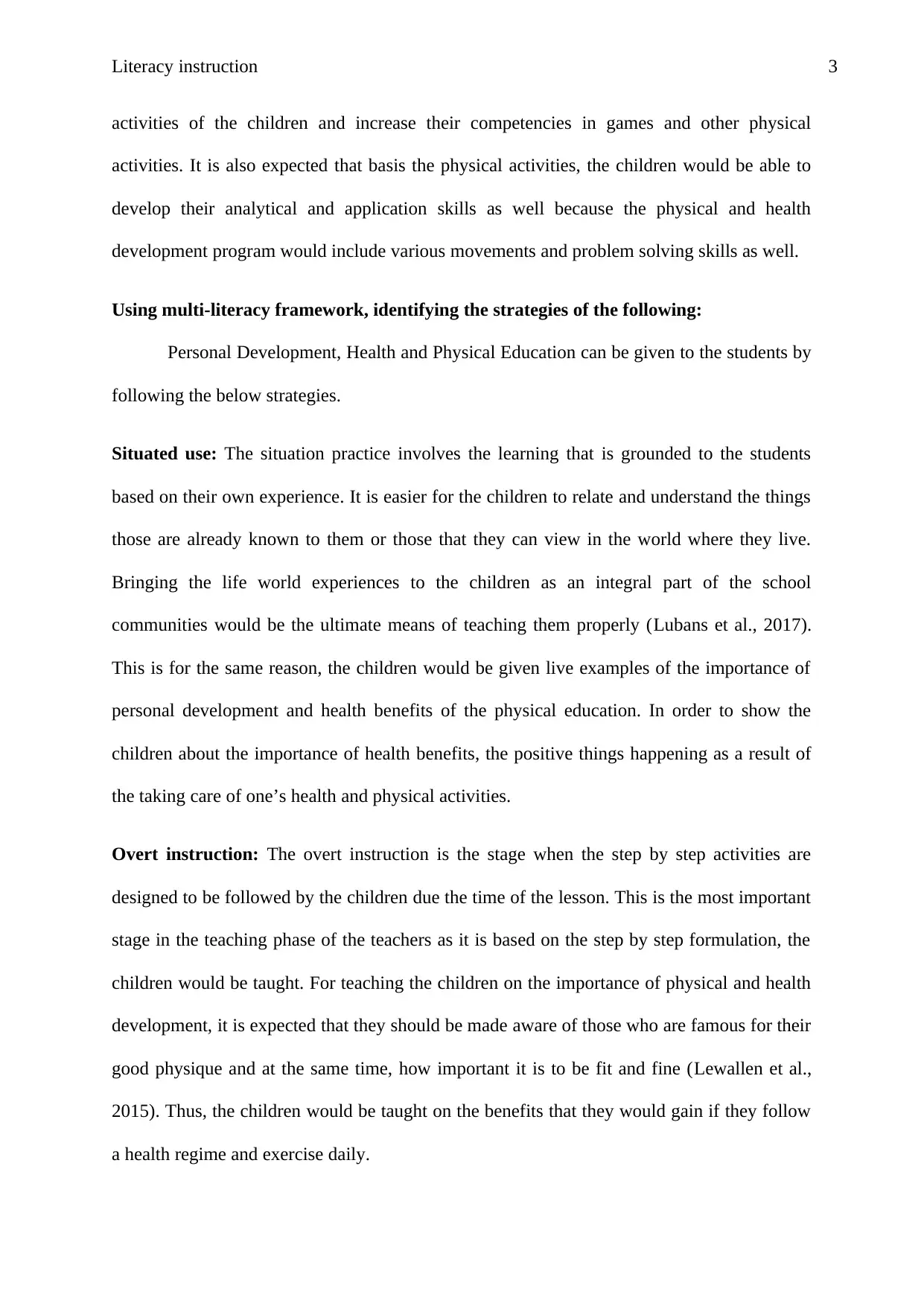
Literacy instruction 3
activities of the children and increase their competencies in games and other physical
activities. It is also expected that basis the physical activities, the children would be able to
develop their analytical and application skills as well because the physical and health
development program would include various movements and problem solving skills as well.
Using multi-literacy framework, identifying the strategies of the following:
Personal Development, Health and Physical Education can be given to the students by
following the below strategies.
Situated use: The situation practice involves the learning that is grounded to the students
based on their own experience. It is easier for the children to relate and understand the things
those are already known to them or those that they can view in the world where they live.
Bringing the life world experiences to the children as an integral part of the school
communities would be the ultimate means of teaching them properly (Lubans et al., 2017).
This is for the same reason, the children would be given live examples of the importance of
personal development and health benefits of the physical education. In order to show the
children about the importance of health benefits, the positive things happening as a result of
the taking care of one’s health and physical activities.
Overt instruction: The overt instruction is the stage when the step by step activities are
designed to be followed by the children due the time of the lesson. This is the most important
stage in the teaching phase of the teachers as it is based on the step by step formulation, the
children would be taught. For teaching the children on the importance of physical and health
development, it is expected that they should be made aware of those who are famous for their
good physique and at the same time, how important it is to be fit and fine (Lewallen et al.,
2015). Thus, the children would be taught on the benefits that they would gain if they follow
a health regime and exercise daily.
activities of the children and increase their competencies in games and other physical
activities. It is also expected that basis the physical activities, the children would be able to
develop their analytical and application skills as well because the physical and health
development program would include various movements and problem solving skills as well.
Using multi-literacy framework, identifying the strategies of the following:
Personal Development, Health and Physical Education can be given to the students by
following the below strategies.
Situated use: The situation practice involves the learning that is grounded to the students
based on their own experience. It is easier for the children to relate and understand the things
those are already known to them or those that they can view in the world where they live.
Bringing the life world experiences to the children as an integral part of the school
communities would be the ultimate means of teaching them properly (Lubans et al., 2017).
This is for the same reason, the children would be given live examples of the importance of
personal development and health benefits of the physical education. In order to show the
children about the importance of health benefits, the positive things happening as a result of
the taking care of one’s health and physical activities.
Overt instruction: The overt instruction is the stage when the step by step activities are
designed to be followed by the children due the time of the lesson. This is the most important
stage in the teaching phase of the teachers as it is based on the step by step formulation, the
children would be taught. For teaching the children on the importance of physical and health
development, it is expected that they should be made aware of those who are famous for their
good physique and at the same time, how important it is to be fit and fine (Lewallen et al.,
2015). Thus, the children would be taught on the benefits that they would gain if they follow
a health regime and exercise daily.
Paraphrase This Document
Need a fresh take? Get an instant paraphrase of this document with our AI Paraphraser
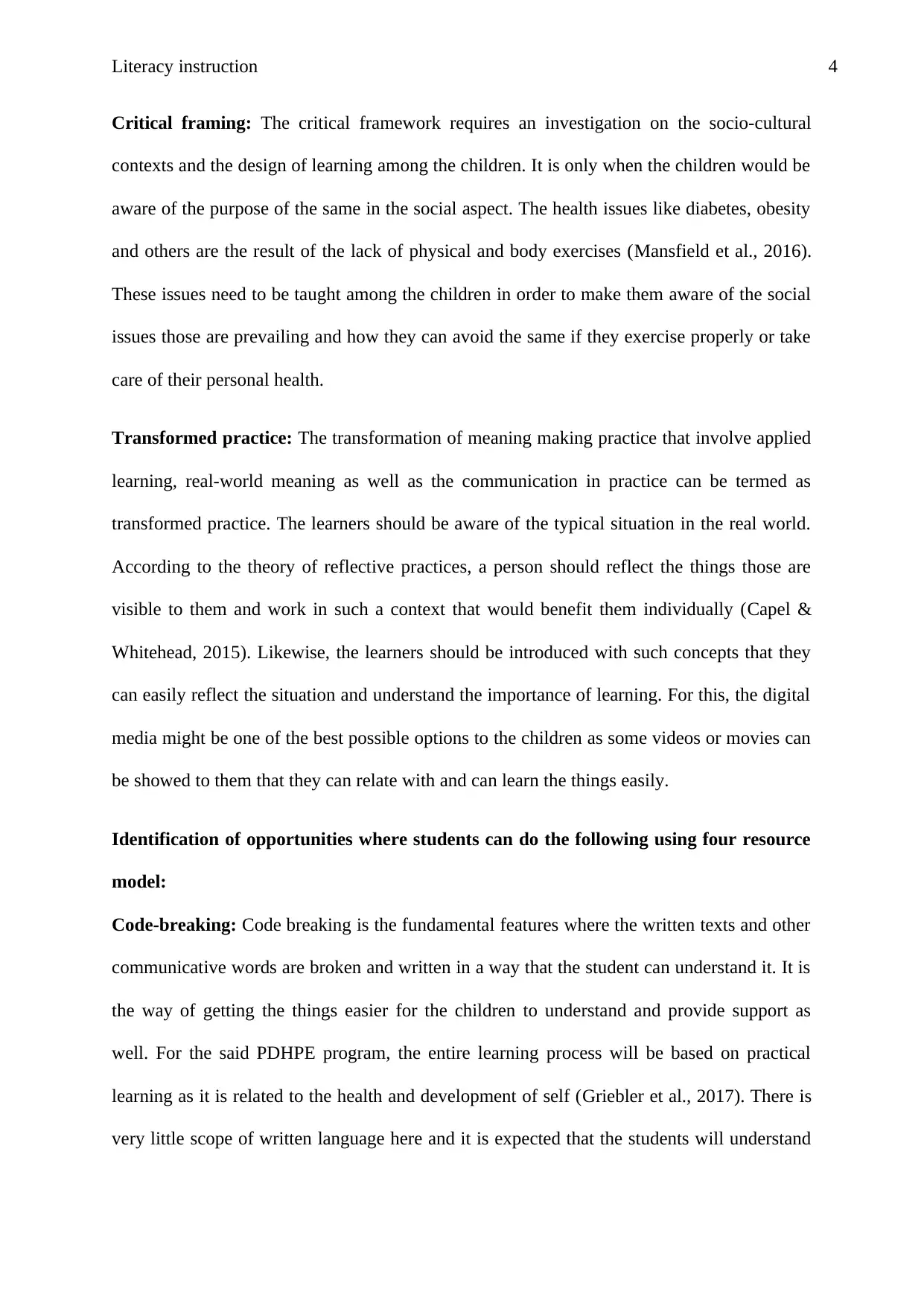
Literacy instruction 4
Critical framing: The critical framework requires an investigation on the socio-cultural
contexts and the design of learning among the children. It is only when the children would be
aware of the purpose of the same in the social aspect. The health issues like diabetes, obesity
and others are the result of the lack of physical and body exercises (Mansfield et al., 2016).
These issues need to be taught among the children in order to make them aware of the social
issues those are prevailing and how they can avoid the same if they exercise properly or take
care of their personal health.
Transformed practice: The transformation of meaning making practice that involve applied
learning, real-world meaning as well as the communication in practice can be termed as
transformed practice. The learners should be aware of the typical situation in the real world.
According to the theory of reflective practices, a person should reflect the things those are
visible to them and work in such a context that would benefit them individually (Capel &
Whitehead, 2015). Likewise, the learners should be introduced with such concepts that they
can easily reflect the situation and understand the importance of learning. For this, the digital
media might be one of the best possible options to the children as some videos or movies can
be showed to them that they can relate with and can learn the things easily.
Identification of opportunities where students can do the following using four resource
model:
Code-breaking: Code breaking is the fundamental features where the written texts and other
communicative words are broken and written in a way that the student can understand it. It is
the way of getting the things easier for the children to understand and provide support as
well. For the said PDHPE program, the entire learning process will be based on practical
learning as it is related to the health and development of self (Griebler et al., 2017). There is
very little scope of written language here and it is expected that the students will understand
Critical framing: The critical framework requires an investigation on the socio-cultural
contexts and the design of learning among the children. It is only when the children would be
aware of the purpose of the same in the social aspect. The health issues like diabetes, obesity
and others are the result of the lack of physical and body exercises (Mansfield et al., 2016).
These issues need to be taught among the children in order to make them aware of the social
issues those are prevailing and how they can avoid the same if they exercise properly or take
care of their personal health.
Transformed practice: The transformation of meaning making practice that involve applied
learning, real-world meaning as well as the communication in practice can be termed as
transformed practice. The learners should be aware of the typical situation in the real world.
According to the theory of reflective practices, a person should reflect the things those are
visible to them and work in such a context that would benefit them individually (Capel &
Whitehead, 2015). Likewise, the learners should be introduced with such concepts that they
can easily reflect the situation and understand the importance of learning. For this, the digital
media might be one of the best possible options to the children as some videos or movies can
be showed to them that they can relate with and can learn the things easily.
Identification of opportunities where students can do the following using four resource
model:
Code-breaking: Code breaking is the fundamental features where the written texts and other
communicative words are broken and written in a way that the student can understand it. It is
the way of getting the things easier for the children to understand and provide support as
well. For the said PDHPE program, the entire learning process will be based on practical
learning as it is related to the health and development of self (Griebler et al., 2017). There is
very little scope of written language here and it is expected that the students will understand
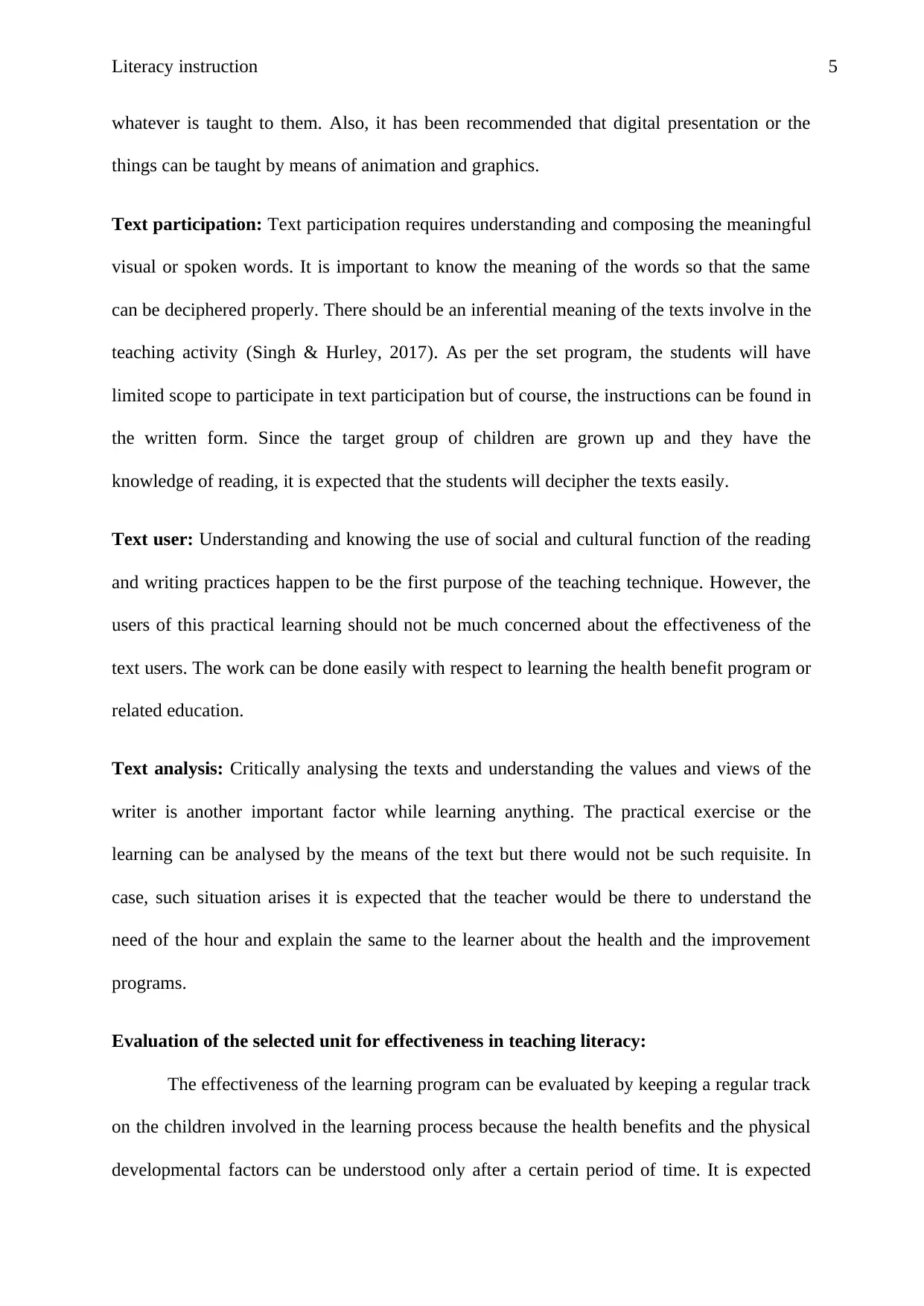
Literacy instruction 5
whatever is taught to them. Also, it has been recommended that digital presentation or the
things can be taught by means of animation and graphics.
Text participation: Text participation requires understanding and composing the meaningful
visual or spoken words. It is important to know the meaning of the words so that the same
can be deciphered properly. There should be an inferential meaning of the texts involve in the
teaching activity (Singh & Hurley, 2017). As per the set program, the students will have
limited scope to participate in text participation but of course, the instructions can be found in
the written form. Since the target group of children are grown up and they have the
knowledge of reading, it is expected that the students will decipher the texts easily.
Text user: Understanding and knowing the use of social and cultural function of the reading
and writing practices happen to be the first purpose of the teaching technique. However, the
users of this practical learning should not be much concerned about the effectiveness of the
text users. The work can be done easily with respect to learning the health benefit program or
related education.
Text analysis: Critically analysing the texts and understanding the values and views of the
writer is another important factor while learning anything. The practical exercise or the
learning can be analysed by the means of the text but there would not be such requisite. In
case, such situation arises it is expected that the teacher would be there to understand the
need of the hour and explain the same to the learner about the health and the improvement
programs.
Evaluation of the selected unit for effectiveness in teaching literacy:
The effectiveness of the learning program can be evaluated by keeping a regular track
on the children involved in the learning process because the health benefits and the physical
developmental factors can be understood only after a certain period of time. It is expected
whatever is taught to them. Also, it has been recommended that digital presentation or the
things can be taught by means of animation and graphics.
Text participation: Text participation requires understanding and composing the meaningful
visual or spoken words. It is important to know the meaning of the words so that the same
can be deciphered properly. There should be an inferential meaning of the texts involve in the
teaching activity (Singh & Hurley, 2017). As per the set program, the students will have
limited scope to participate in text participation but of course, the instructions can be found in
the written form. Since the target group of children are grown up and they have the
knowledge of reading, it is expected that the students will decipher the texts easily.
Text user: Understanding and knowing the use of social and cultural function of the reading
and writing practices happen to be the first purpose of the teaching technique. However, the
users of this practical learning should not be much concerned about the effectiveness of the
text users. The work can be done easily with respect to learning the health benefit program or
related education.
Text analysis: Critically analysing the texts and understanding the values and views of the
writer is another important factor while learning anything. The practical exercise or the
learning can be analysed by the means of the text but there would not be such requisite. In
case, such situation arises it is expected that the teacher would be there to understand the
need of the hour and explain the same to the learner about the health and the improvement
programs.
Evaluation of the selected unit for effectiveness in teaching literacy:
The effectiveness of the learning program can be evaluated by keeping a regular track
on the children involved in the learning process because the health benefits and the physical
developmental factors can be understood only after a certain period of time. It is expected
⊘ This is a preview!⊘
Do you want full access?
Subscribe today to unlock all pages.

Trusted by 1+ million students worldwide
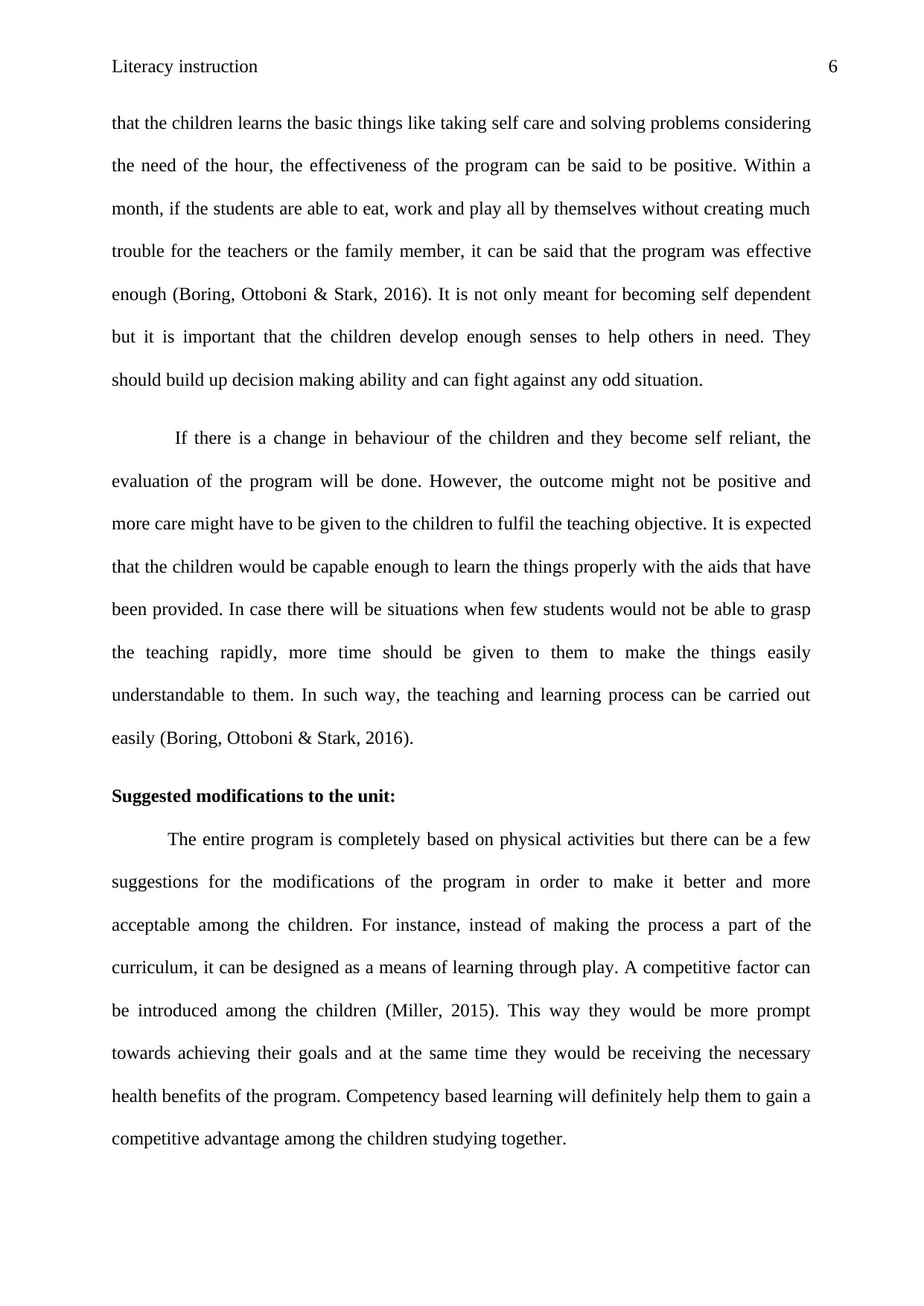
Literacy instruction 6
that the children learns the basic things like taking self care and solving problems considering
the need of the hour, the effectiveness of the program can be said to be positive. Within a
month, if the students are able to eat, work and play all by themselves without creating much
trouble for the teachers or the family member, it can be said that the program was effective
enough (Boring, Ottoboni & Stark, 2016). It is not only meant for becoming self dependent
but it is important that the children develop enough senses to help others in need. They
should build up decision making ability and can fight against any odd situation.
If there is a change in behaviour of the children and they become self reliant, the
evaluation of the program will be done. However, the outcome might not be positive and
more care might have to be given to the children to fulfil the teaching objective. It is expected
that the children would be capable enough to learn the things properly with the aids that have
been provided. In case there will be situations when few students would not be able to grasp
the teaching rapidly, more time should be given to them to make the things easily
understandable to them. In such way, the teaching and learning process can be carried out
easily (Boring, Ottoboni & Stark, 2016).
Suggested modifications to the unit:
The entire program is completely based on physical activities but there can be a few
suggestions for the modifications of the program in order to make it better and more
acceptable among the children. For instance, instead of making the process a part of the
curriculum, it can be designed as a means of learning through play. A competitive factor can
be introduced among the children (Miller, 2015). This way they would be more prompt
towards achieving their goals and at the same time they would be receiving the necessary
health benefits of the program. Competency based learning will definitely help them to gain a
competitive advantage among the children studying together.
that the children learns the basic things like taking self care and solving problems considering
the need of the hour, the effectiveness of the program can be said to be positive. Within a
month, if the students are able to eat, work and play all by themselves without creating much
trouble for the teachers or the family member, it can be said that the program was effective
enough (Boring, Ottoboni & Stark, 2016). It is not only meant for becoming self dependent
but it is important that the children develop enough senses to help others in need. They
should build up decision making ability and can fight against any odd situation.
If there is a change in behaviour of the children and they become self reliant, the
evaluation of the program will be done. However, the outcome might not be positive and
more care might have to be given to the children to fulfil the teaching objective. It is expected
that the children would be capable enough to learn the things properly with the aids that have
been provided. In case there will be situations when few students would not be able to grasp
the teaching rapidly, more time should be given to them to make the things easily
understandable to them. In such way, the teaching and learning process can be carried out
easily (Boring, Ottoboni & Stark, 2016).
Suggested modifications to the unit:
The entire program is completely based on physical activities but there can be a few
suggestions for the modifications of the program in order to make it better and more
acceptable among the children. For instance, instead of making the process a part of the
curriculum, it can be designed as a means of learning through play. A competitive factor can
be introduced among the children (Miller, 2015). This way they would be more prompt
towards achieving their goals and at the same time they would be receiving the necessary
health benefits of the program. Competency based learning will definitely help them to gain a
competitive advantage among the children studying together.
Paraphrase This Document
Need a fresh take? Get an instant paraphrase of this document with our AI Paraphraser
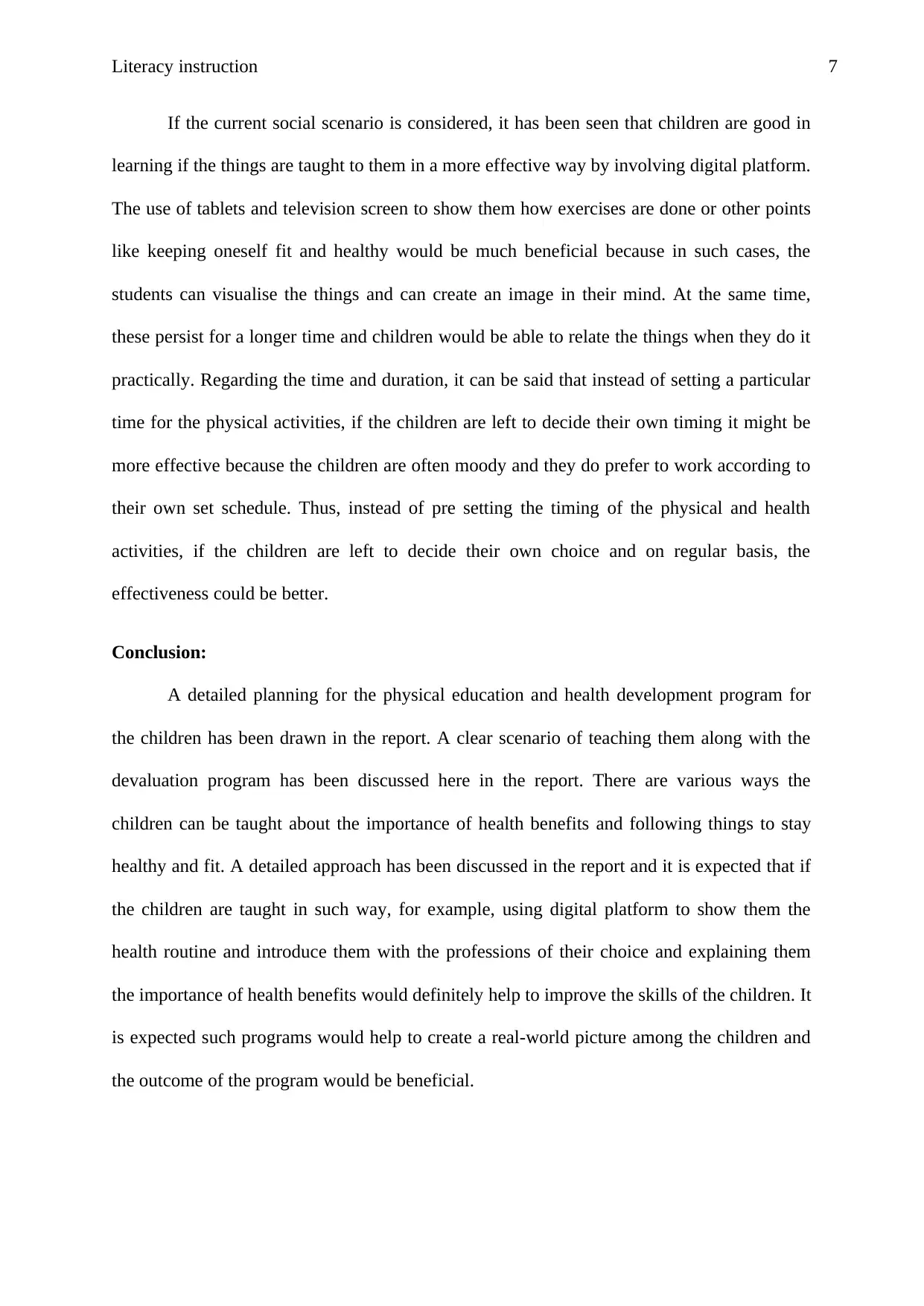
Literacy instruction 7
If the current social scenario is considered, it has been seen that children are good in
learning if the things are taught to them in a more effective way by involving digital platform.
The use of tablets and television screen to show them how exercises are done or other points
like keeping oneself fit and healthy would be much beneficial because in such cases, the
students can visualise the things and can create an image in their mind. At the same time,
these persist for a longer time and children would be able to relate the things when they do it
practically. Regarding the time and duration, it can be said that instead of setting a particular
time for the physical activities, if the children are left to decide their own timing it might be
more effective because the children are often moody and they do prefer to work according to
their own set schedule. Thus, instead of pre setting the timing of the physical and health
activities, if the children are left to decide their own choice and on regular basis, the
effectiveness could be better.
Conclusion:
A detailed planning for the physical education and health development program for
the children has been drawn in the report. A clear scenario of teaching them along with the
devaluation program has been discussed here in the report. There are various ways the
children can be taught about the importance of health benefits and following things to stay
healthy and fit. A detailed approach has been discussed in the report and it is expected that if
the children are taught in such way, for example, using digital platform to show them the
health routine and introduce them with the professions of their choice and explaining them
the importance of health benefits would definitely help to improve the skills of the children. It
is expected such programs would help to create a real-world picture among the children and
the outcome of the program would be beneficial.
If the current social scenario is considered, it has been seen that children are good in
learning if the things are taught to them in a more effective way by involving digital platform.
The use of tablets and television screen to show them how exercises are done or other points
like keeping oneself fit and healthy would be much beneficial because in such cases, the
students can visualise the things and can create an image in their mind. At the same time,
these persist for a longer time and children would be able to relate the things when they do it
practically. Regarding the time and duration, it can be said that instead of setting a particular
time for the physical activities, if the children are left to decide their own timing it might be
more effective because the children are often moody and they do prefer to work according to
their own set schedule. Thus, instead of pre setting the timing of the physical and health
activities, if the children are left to decide their own choice and on regular basis, the
effectiveness could be better.
Conclusion:
A detailed planning for the physical education and health development program for
the children has been drawn in the report. A clear scenario of teaching them along with the
devaluation program has been discussed here in the report. There are various ways the
children can be taught about the importance of health benefits and following things to stay
healthy and fit. A detailed approach has been discussed in the report and it is expected that if
the children are taught in such way, for example, using digital platform to show them the
health routine and introduce them with the professions of their choice and explaining them
the importance of health benefits would definitely help to improve the skills of the children. It
is expected such programs would help to create a real-world picture among the children and
the outcome of the program would be beneficial.
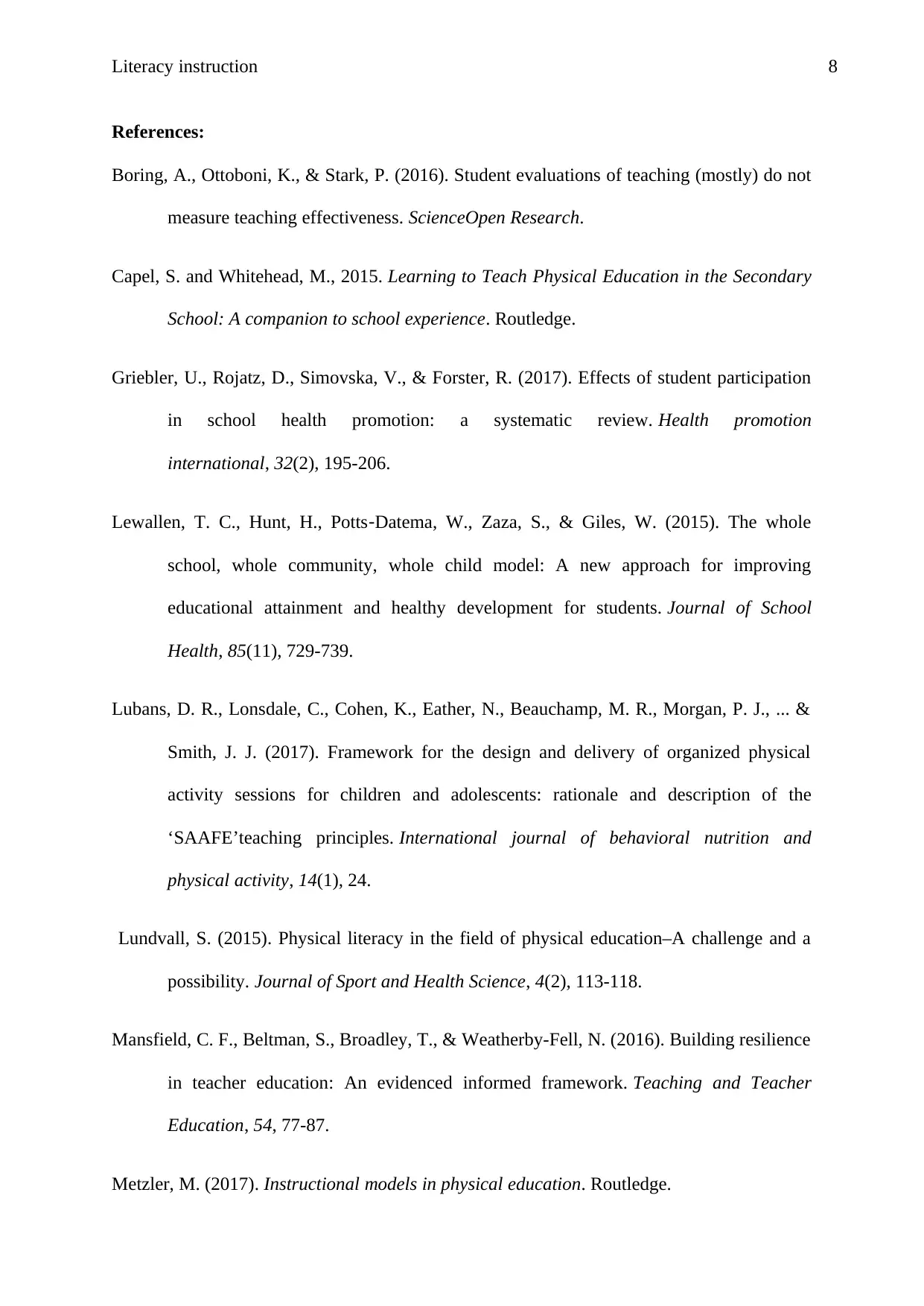
Literacy instruction 8
References:
Boring, A., Ottoboni, K., & Stark, P. (2016). Student evaluations of teaching (mostly) do not
measure teaching effectiveness. ScienceOpen Research.
Capel, S. and Whitehead, M., 2015. Learning to Teach Physical Education in the Secondary
School: A companion to school experience. Routledge.
Griebler, U., Rojatz, D., Simovska, V., & Forster, R. (2017). Effects of student participation
in school health promotion: a systematic review. Health promotion
international, 32(2), 195-206.
Lewallen, T. C., Hunt, H., Potts‐Datema, W., Zaza, S., & Giles, W. (2015). The whole
school, whole community, whole child model: A new approach for improving
educational attainment and healthy development for students. Journal of School
Health, 85(11), 729-739.
Lubans, D. R., Lonsdale, C., Cohen, K., Eather, N., Beauchamp, M. R., Morgan, P. J., ... &
Smith, J. J. (2017). Framework for the design and delivery of organized physical
activity sessions for children and adolescents: rationale and description of the
‘SAAFE’teaching principles. International journal of behavioral nutrition and
physical activity, 14(1), 24.
Lundvall, S. (2015). Physical literacy in the field of physical education–A challenge and a
possibility. Journal of Sport and Health Science, 4(2), 113-118.
Mansfield, C. F., Beltman, S., Broadley, T., & Weatherby-Fell, N. (2016). Building resilience
in teacher education: An evidenced informed framework. Teaching and Teacher
Education, 54, 77-87.
Metzler, M. (2017). Instructional models in physical education. Routledge.
References:
Boring, A., Ottoboni, K., & Stark, P. (2016). Student evaluations of teaching (mostly) do not
measure teaching effectiveness. ScienceOpen Research.
Capel, S. and Whitehead, M., 2015. Learning to Teach Physical Education in the Secondary
School: A companion to school experience. Routledge.
Griebler, U., Rojatz, D., Simovska, V., & Forster, R. (2017). Effects of student participation
in school health promotion: a systematic review. Health promotion
international, 32(2), 195-206.
Lewallen, T. C., Hunt, H., Potts‐Datema, W., Zaza, S., & Giles, W. (2015). The whole
school, whole community, whole child model: A new approach for improving
educational attainment and healthy development for students. Journal of School
Health, 85(11), 729-739.
Lubans, D. R., Lonsdale, C., Cohen, K., Eather, N., Beauchamp, M. R., Morgan, P. J., ... &
Smith, J. J. (2017). Framework for the design and delivery of organized physical
activity sessions for children and adolescents: rationale and description of the
‘SAAFE’teaching principles. International journal of behavioral nutrition and
physical activity, 14(1), 24.
Lundvall, S. (2015). Physical literacy in the field of physical education–A challenge and a
possibility. Journal of Sport and Health Science, 4(2), 113-118.
Mansfield, C. F., Beltman, S., Broadley, T., & Weatherby-Fell, N. (2016). Building resilience
in teacher education: An evidenced informed framework. Teaching and Teacher
Education, 54, 77-87.
Metzler, M. (2017). Instructional models in physical education. Routledge.
⊘ This is a preview!⊘
Do you want full access?
Subscribe today to unlock all pages.

Trusted by 1+ million students worldwide
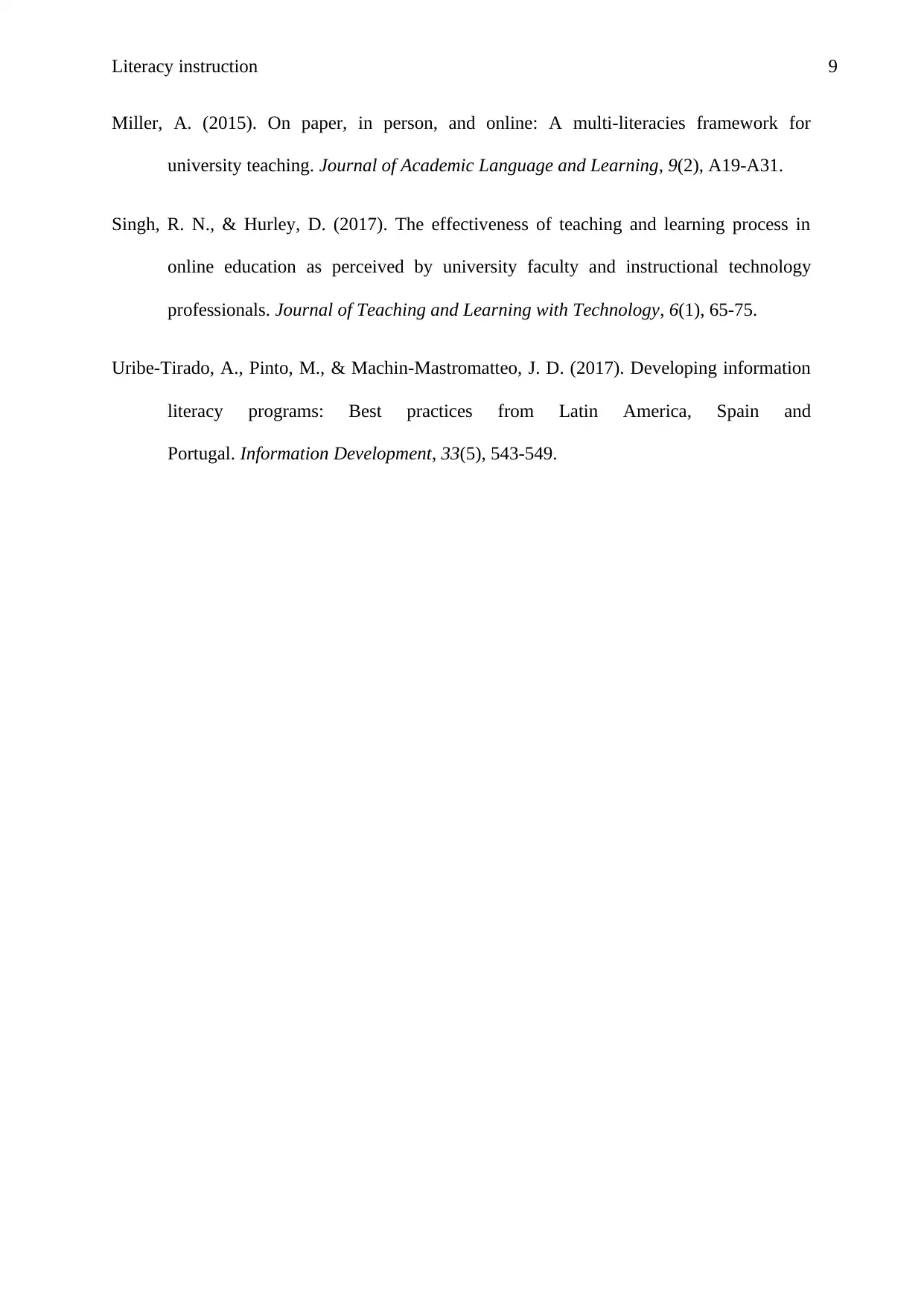
Literacy instruction 9
Miller, A. (2015). On paper, in person, and online: A multi-literacies framework for
university teaching. Journal of Academic Language and Learning, 9(2), A19-A31.
Singh, R. N., & Hurley, D. (2017). The effectiveness of teaching and learning process in
online education as perceived by university faculty and instructional technology
professionals. Journal of Teaching and Learning with Technology, 6(1), 65-75.
Uribe-Tirado, A., Pinto, M., & Machin-Mastromatteo, J. D. (2017). Developing information
literacy programs: Best practices from Latin America, Spain and
Portugal. Information Development, 33(5), 543-549.
Miller, A. (2015). On paper, in person, and online: A multi-literacies framework for
university teaching. Journal of Academic Language and Learning, 9(2), A19-A31.
Singh, R. N., & Hurley, D. (2017). The effectiveness of teaching and learning process in
online education as perceived by university faculty and instructional technology
professionals. Journal of Teaching and Learning with Technology, 6(1), 65-75.
Uribe-Tirado, A., Pinto, M., & Machin-Mastromatteo, J. D. (2017). Developing information
literacy programs: Best practices from Latin America, Spain and
Portugal. Information Development, 33(5), 543-549.
1 out of 10
Related Documents
Your All-in-One AI-Powered Toolkit for Academic Success.
+13062052269
info@desklib.com
Available 24*7 on WhatsApp / Email
![[object Object]](/_next/static/media/star-bottom.7253800d.svg)
Unlock your academic potential
Copyright © 2020–2025 A2Z Services. All Rights Reserved. Developed and managed by ZUCOL.





